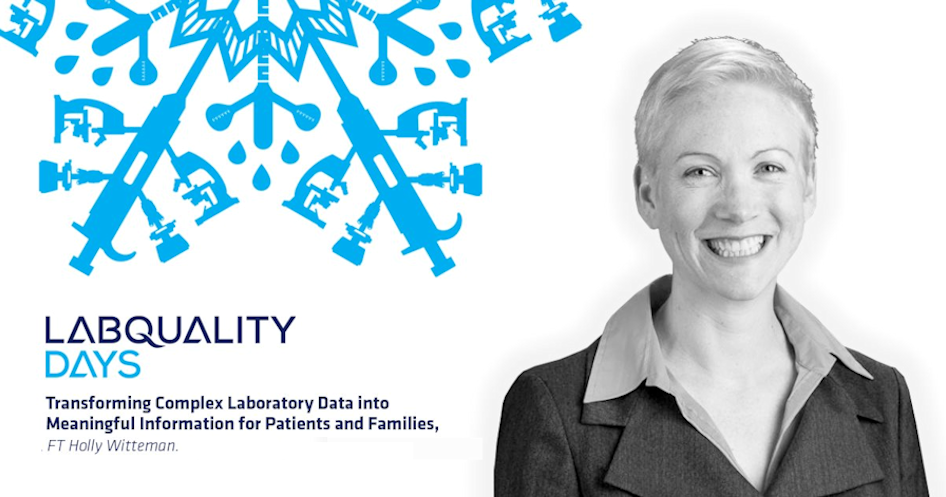How to communicate laboratory results to patients?

Associate professor Holly Witteman from Laval University, Quebec City, Canada gives an opening lecture at the International Congress on Quality in Laboratory Medicine on Thursday 6 February 2020. Professor Witteman highlights that people are increasingly able to access their laboratory results directly via patient portals and that is a positive development because it has the potential to help improve health and self-management, especially among people living with chronic conditions. However, some health professionals and others are concerned about the potential for test results to cause confusion or anxiety among patients. This talk will discuss how to ensure that results are presented to patients in optimal ways.
About the Speaker: Holly Witteman
 Holly Witteman, PhD, is an Associate Professor in the Department of Family & Emergency Medicine, Université Laval (Laval University), Quebec City, Canada. Quebec City is unceded traditional territory of the Huron-Wendat, Abenaki, Wolastoqiyik (Maliseet) & Haudenosaunee peoples. Dr. Witteman directs the research unit within the Faculty of Medicine’s Office of Education and Professional Development (VDPDPC). She is also a scientist in the Primary Care Research research centre affiliated with Laval University (CERSSPL-UL), the Research Centre of the CHU de Québec-Université Laval (CRCHU-UL), and an Affiliate Investigator at the Ottawa Hospital Research Institute, Ottawa, Canada. With an interdisciplinary background in human factors engineering and social sciences, her research is about person-centered digital health, including a focus on how best to adapt technology to people rather than expecting people to adapt to technology. She specializes in human-computer interaction in health education, risk communication and decision making, including design methods to support inclusive user- and patient-centeredness. Her work as Principal Investigator has been funded by the Fonds de recherche du Québec – Santé (FRQS), the Patient-Centered Outcomes Research Institute (PCORI, United States), the Canada Foundation for Innovation (CFI), and the Canadian Institutes of Health Research (CIHR).
Holly Witteman, PhD, is an Associate Professor in the Department of Family & Emergency Medicine, Université Laval (Laval University), Quebec City, Canada. Quebec City is unceded traditional territory of the Huron-Wendat, Abenaki, Wolastoqiyik (Maliseet) & Haudenosaunee peoples. Dr. Witteman directs the research unit within the Faculty of Medicine’s Office of Education and Professional Development (VDPDPC). She is also a scientist in the Primary Care Research research centre affiliated with Laval University (CERSSPL-UL), the Research Centre of the CHU de Québec-Université Laval (CRCHU-UL), and an Affiliate Investigator at the Ottawa Hospital Research Institute, Ottawa, Canada. With an interdisciplinary background in human factors engineering and social sciences, her research is about person-centered digital health, including a focus on how best to adapt technology to people rather than expecting people to adapt to technology. She specializes in human-computer interaction in health education, risk communication and decision making, including design methods to support inclusive user- and patient-centeredness. Her work as Principal Investigator has been funded by the Fonds de recherche du Québec – Santé (FRQS), the Patient-Centered Outcomes Research Institute (PCORI, United States), the Canada Foundation for Innovation (CFI), and the Canadian Institutes of Health Research (CIHR).
Abstract: Transforming Complex Laboratory Data into Meaningful Information for
Patients and Families
Laboratory results are increasingly available directly to people with little to no formal training in how to interpret them. Echoing concerns expressed almost fifty years ago when home pregnancy tests first became available, some professionals worry about patients receiving direct access to their own results regarding their hemoglobin A1c, platelet count, alanine aminotransferase, or serum creatinine. Such concerns might be well-meaning, but they are fundamentally opposed to the rights and interests of those who wish to be more involved in their own health care. Access to laboratory results can improve people’s health care experiences and their health. Positive effects may be especially notable among those living with chronic illnesses. However, providing results directly to patients or their families means that results must be understandable by non-specialists. Laboratory results are simply data. Without further context, they are devoid of meaning. Results must be contextualized to turn them into meaningful information, and then actionable knowledge. Doing this requires developing an understanding of how humans perceive and understand laboratory results, then adapting presentations of laboratory results to align with the ways humans naturally perceive, think, and act. In other words, transforming complex laboratory data into meaningful information for patients and families requires improving the interface between humans and their laboratory results. Bret Victor, one of the first user interface designers for the iPad, once explained, “Back in the days of Roman numerals, basic multiplication was considered this incredibly technical concept that only official mathematicians could handle. But then once Arabic numerals came around, you could actually do arithmetic on paper, and we found that 7-year-olds can understand multiplication. It’s not that multiplication itself was difficult. It was just that the representation of numbers — the interface — was wrong.” Although triglyceride levels, HDL, LDL, and total cholesterol may be somewhat less familiar to most people than simple multiplication, the challenge is the same: to develop usable interfaces so that people can more easily draw meaning from their results.
This talk will address how to develop usable interfaces for laboratory results, drawing on lessons learned from projects in various countries. The overall approach discussed will be a collection of overlapping, related methods called user-centered design, human-centered design, design thinking, co-design, or other terms describing methods that aim to adapt interfaces to people, rather than require people to adapt to interfaces.
Labquality Days – International Congress on Quality in Laboratory Medicine
Welcome to the International Congress on Quality in Laboratory Medicine on 6-7 February 2020. The scientific program of the next International Congress on Quality in Laboratory Medicine will be built around the theme of optimizing quality. The program covers the topics on harmonization of medical practices, how to communicate the results to clinicians and patients and the quality assurance of new measurement technologies. Welcome to Helsinki!


